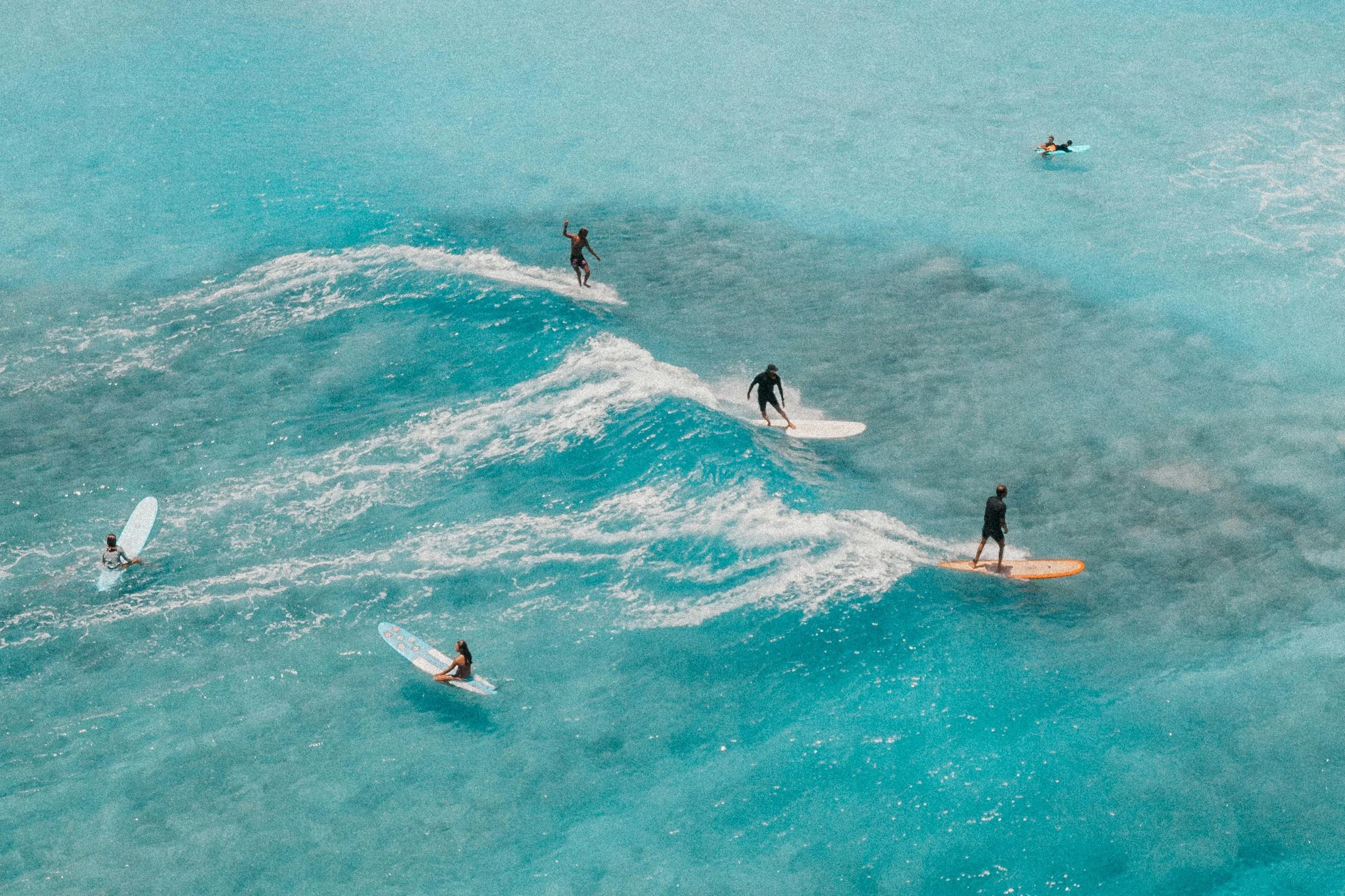Surf Etiquette for Beginners
Surfing is a bit different than many other sports. It’s less structured on the surface, and more free. It’s one of the things I truly love about surfing. In a sense, there’s no real rules. However, there are waves and an ocean to share, other people to consider, and unwritten rules to follow.
Surf etiquette is something that is fairly common all over the world. What applies to one lineup often will apply to another. When you’re new, it may feel overwhelming with all of the different surfers flying around. However, if you want to learn how to start surfing, you absolutely must learn surf etiquette. It’s one of our 14 Tips for Beginner Surfers: learn surf etiquette! Take it seriously.
Basics of Surf Etiquette
Here we’ll cover the basics of surf etiquette. This is not a comprehensive list. I’ve surely forgotten something and will add to this list, but it is a good start.
Surf in the Right Spot
This is one of the most basics rules of surf etiquette that starts before you even get in the water. It starts with being honest with yourself. There’s a saying, “If in doubt, don’t paddle out.” If the wave is beyond your skill level, don’t get in the water. You don’t want to endanger yourself or other surfers. If you’re a beginner, find a good place to learn how to surf, and don’t try to paddle out at Pipeline.
Furthermore, if you’re at a break with a crowded lineup, don’t crowd the locals or advanced surfers. Some breaks have peaks up and down the beach, like Playa Hermosa in Costa Rica. Recognize your own skill level and stick to the right waves. If all of the advanced surfers are at one peak, don’t go try to catch waves there unless you can hold your own. You don’t want to be consistently bailing on waves and burning the more seasoned surfers. Stick to the spots you can surf.
No Snaking
Snaking is maybe the top way to really piss off other surfers other than dropping in. For me, they’re both pretty similarly annoying. It’s also something many beginner or relatively new surfers do without realizing they’re doing it. At it’s simplest, snaking is stealing a wave from someone when it wasn’t their wave to begin with.
Here’s how it goes. Let’s say you’re sitting there waiting for a wave, in the priority spot. As a wave rolls in and you’re paddling for the wave clearly, another surfer surfs around you to get closer to the peak and catch the wave. It may look at first glance like you’re dropping in on this other surfer as they’re closer to the peak, but really you just got snaked.
There are some types of exceptions to this rule, like respecting locals (more on this later), but in general snaking is a big no in the surf community. You don’t want to be a wave hog and quite literally steal a wave from someone else. It’s a surefire way to make enemies instead of friends.
Don’t Drop In
On a somewhat similar note, don’t drop in on other people! The etiquette surrounding wave priority is fairly simple. The surfer closest to the peak generally has priority. If you and somebody else are both paddling for a left, but there other surfer is to your right, they have the priority. As soon as they go to pop up, pull off. It’s their wave.
The big exception here has to do with who is standing. If you’re paddling for a wave close to the peak but there’s already a surfer out on the shoulder and standing, it’s not your wave. Once a surfer is up and surfing a wave, it doesn’t matter how close to the peak you are. It’s not your wave at that point.
Paddle Wide
This offense is one you’ll see at many beginner spots. It happens a ton at our local break. We’ll take the example of a point break like we have here but it is true for different types of surf breaks. With a point break, the waves generally break in the same spot and move down the line. You can see this in the whitewater, showing where the wave is breaking (see photo below).
When you paddle back out, don’t paddle through this section! This is quite obviously where the surfers will be coming down the line and riding the wave, so steer clear. Know how to paddle your board well so you can get out of the way, and paddle wide around the breaking wave so you aren’t getting in anyone’s way. Yes, this may be a longer paddle or inconvenient for you, but it keeps everyone safe.
Form a Line
Okay, you don’t literally need to form a line, but I didn’t know how else to put it. Take turns? When there’s a consistent takeoff spot at a point or reef break, don’t be a wave hog. If a surfer just caught a wave, when they paddle back out they shouldn’t take the first wave available. Again, there’s an exception here when it comes to locals.
In general, if you catch a wave and paddle back out to three people sitting there in the lineup, you should wait your turn. As surfers catch waves, the “line” will generally move closer to the takeoff spot. Don’t snake people, and just wait for your turn to go. On this note, if you’re on a longboard, don’t be the person who paddles out to the back and steals every wave.
Respect Locals
On to one of the biggest parts of surf etiquette, and one we’ve referenced a few times here. Local rules differ from place to place. If it’s unclear who the locals are, try to pay attention and see who runs the spot. If you go to the spot semi-regularly, you’ll likely get to know the locals pretty quickly. With all of the rules of surfing, remember that locals play by their own rules. Respect them.
In many places, a local gets priority on the wave. It doesn’t matter if they’re closer to the peak or if it’s their turn. It’s your job as a visiting surfer to recognize if they’re being a kook or they’re simply a local. In some places, surf lessons get priority. For example, in El Paredón, local and visiting surfers pull off waves for the local coaches teaching classes. The hierarchy there goes local coaches -> locals -> visitors.
Communicate
I’ve spent a lot of time surfing some breaks, like in Cancún, where I don’t know most of the people out there. They have their crew, we have ours, and everyone’s friendly. But we’re not out there chatting in the lineup. However, when it comes time to get a wave, everyone communicates.
Communication can be super useful on A-frame waves. Two people can generally catch these waves, so it’s useful to shout if you’re going left or right so the other surfer knows they’re good to go the other way. It can also be useful to shout that you’re on the wave if you see someone about to drop in on you. This can simply prevent them from doing so, and keep everyone safe. Don’t be a dick, but feel free to be loud to let the other person know! If you’re surfing in Latin America, it can be helpful to learn some basic Spanish surf terms.
Don’t Ditch the Board
This is a pretty simple one I think. When we’re new to surfing and a big set comes, we may have the habit of ditching the board to dive under the wave. This is more okay if you’re not surfing a crowded spot, but I still don’t recommend it as it can cause injuries or broken leashes.
In a more crowded spot, this is absolutely not okay. Ditching your board puts other surfers at risk. Your board might get messed up if someone runs it over, but you also might seriously injure someone else. Hold onto your board, keep it near you, and don’t let it flop around in the waves.
Apologize
I’ll admit, apologizing doesn’t always go as planned with surfers. When I was relatively new to surfing, I ran right over someone. He duck dived, and I didn’t actually get him. But the moment I got back out to the lineup, I apologized and checked to make sure he and his board were okay. He was super cool about it, and we’re quite friendly now years later.
On the other hand, I was out with a friend who paddled back out without going wide, and someone dropped in and rode right over his board. My friend’s board was sliced up, and the other surfer was completely fine. My friend went to apologize and the other surfer wanted a fight. It was fine, nobody fought or got hurt, but sometimes apologies don’t fix everything.
However, apologize anyway. If you make a mistake or think you might have even possibly made a mistake, own up to it. Don’t just shy away from it or ignore it.
Don’t Go Straight
Finally, don’t go straight down a wave where everyone is going down the line. Going straight toward the beach is what most beginners do, and it’s part of learning to surf. There’s nothing wrong with this step of surfing. Where it becomes a problem is when you cut off other surfers. This happens at many beginner/intermediate breaks and can be quite dangerous.
If someone is flying down the line, and you just take a wave straight toward shore, you’re going to be cutting right across their path. These collisions can be super gnarly and are completely avoidable. If you’re at the stage where you can only go straight, or perhaps can’t quite get down the line, make sure you’re surfing in a place where other people won’t be coming toward you.
With all of this info, the real thing to remember is to be mindful of other surfers in the water. Protect your own safety and that of the other surfers. Surf etiquette helps us understand what’s going on in the water, give it some structure, and keep everyone safe.





























